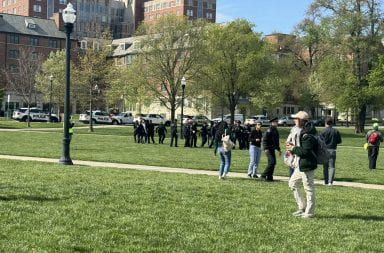Change is coming to Ohio State in the form of an updated student code of conduct that redefines “consent” in cases of sexual misconduct.
The Ohio State Board of Trustees approved the revisions in a board meeting Friday. The code was last revised in 2007.
The code of conduct defines sexual misconduct as “Physical contact or other non-physical conduct of a sexual nature in the absence of clear, knowing and voluntary consent,” and consent as “the act of knowingly and voluntarily agreeing verbally or non-verbally to engage in sexual activity.”
Andrea Goldblum, director for Student Conduct in the Office of Student Life, said the definition for consent has changed.
“The new definition lists that consent must be freely given and can be withdrawn at any time,” Goldblum said.
University Senate approved these changes March 15, according to an agenda from the Trustees’ meeting.
No changes were made to the code in direct response to any campus events, but the committee did take suggestions from students and student organizations, Goldblum said. One of the instrumental groups in making the changes was the Women and Allies Rising in Resistance.
WARR is a group which “works toward improving the status of women on the OSU campus and encourages women to identify, develop and utilize their individual potentials,” according to its website.
President of WARR, Tess Sabo, a fifth-year in environmental policy and management, said revising the definition of consent was very important to her organization.
“We protested the last two years about the absence of a sexual violence policy,” Sabo said.
The group, Sabo said, met with Javaune Adams-Gaston, vice president for student life, about creating such a policy, but she suggested the group work to weave its policy idea into the student code of conduct because “a policy wouldn’t cut it.”
Adams-Gaston mentioned to Sabo that the code of conduct was up for review soon.
“After weeks of discussion, we finally settled on the language we liked,” Sabo said. “That was the hardest part. Everyone was on board with the same sentiments, so we just had to work to get the language right. We needed to have something that was strong enough.”
While the group has not seen the final product of its efforts, Sabo said it was glad to be able to work with the university on this issue because it was important to the group.
In addition to redefining “consent,” the appeals process in cases of sexual misconduct has been altered due to guidance from the U.S. Department of Education’s Office of Civil Rights.
Goldblum said under the unrevised code, those accused in a sexual misconduct case are able to ask for an appeal, but the policy has been altered in order to give “equal rights to victims.” Under the revised code, victims are able to request an appeal for their cases as well.
Callie Tucker, a second-year in history, said she was glad to see the university take steps to ensure the safety of students.
“My former suitemate recently filed for a restraining order against someone who grabbed at her in the dark right outside Lincoln (Tower),” Tucker said. “It happened right here on campus. It could happen anywhere.”
A separate goal of revising the code was to “make it more readable, modernize the language and use bulleted points for easier understanding,” Goldblum said.
The committee in charge of revising the code is made up mainly of students, Goldblum said, and they review the code of conduct regularly.
Revising the code is a yearlong process, and due to the amount of time the committee needs to review the code, it meets every five years instead of the previous system of meeting every three years, Goldblum said.
“The committee goes through the code word-by-word, section-by-section, searching for changes they think will be beneficial,” Goldblum said. “Changes are made to make the code more understandable and to align with the law.”
Sabo said she appreciates the university’s work and compliance with her organization, but she does not think their job is done yet.
The code is set to redefine consent as WARR wanted, but Sabo said she thinks there is “still a lot of work to be done to make OSU a truly safe campus.”
Sabo said she would like to see a change to the culture and environment of the university.
“I’d like to see a campus where you don’t need repercussions for sexual violence because no one would even think about committing it, and everyone would know what consent is,” Sabo said.
Lindsey Barrett contributed to this story.


